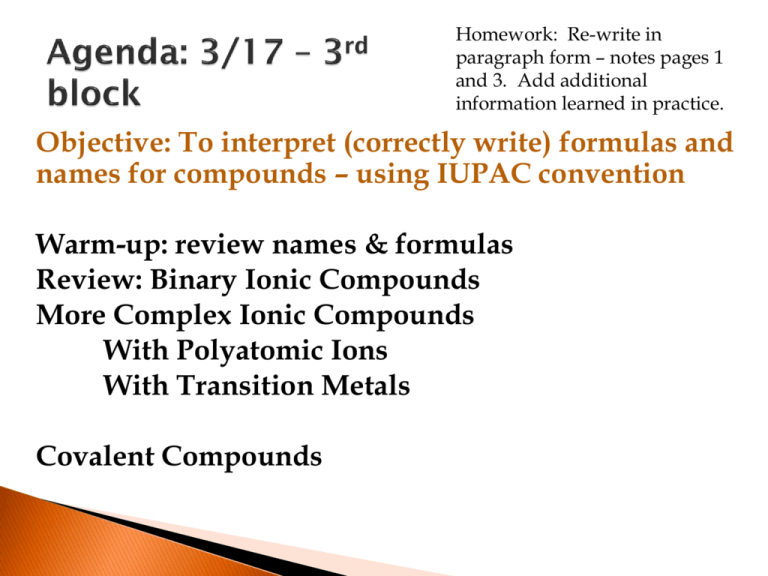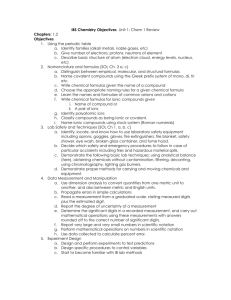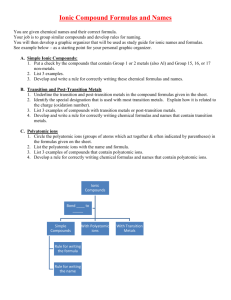Writing Formulas - ChemistryatBiotech
advertisement

Homework: Re-write in paragraph form – notes pages 1 and 3. Add additional information learned in practice. Objective: To interpret (correctly write) formulas and names for compounds – using IUPAC convention Warm-up: review names & formulas Review: Binary Ionic Compounds More Complex Ionic Compounds With Polyatomic Ions With Transition Metals Covalent Compounds Formula MgCl₂ SO₂ PCl₃ AlBr₃ K₃N BrO₃ H₂O Type of Bond and Compound Name Inorganic Compounds Covalent (molecul es) Ioni c M& NM With Roman numeral 3 or more elements NM & NM Diatomic Molecules Acids Metals lose valence electrons Non-metals gain valence electrons Ionic bonding occurs when a metal loses 1 or more electrons to a non-metal in an effort to attain a stable octet of valence electrons. Use Electron Dot Diagrams (Lewis diagrams) to show the ionic bonds for one formula unit. Na Cl = Na⁺¹Cl⁻¹ Cl Ca Cl = Ca Cl Include polyatomic ions Barite = BaSO₄ Used to make paper & glass Source of barium used For x-rays of the digestive system Gypsum = CaSO₄· 2H₂O Used for plaster for walls, ceilings, sculptures Calcite = CaCO₃ Used in paint, Antacids, calcium Supplement for food Calcium sulfate in casts Acetate uses Barium sulfate to absorb x-rays Sodium acetate In Heat packs Sodium hydrogen carbonate (old name: sodium bicarbonate) Medical: used in emergency situations to correct pH of blood Baking soda: to make cakes rise Bleach Dentistry: Clean and disinfect Root canals Rocket fuels: Source of oxygen Examine the names & formulas: What is the pattern? Do they end in “–ide?” Ions with -1 charge perbromate BrO4-1 bromate BrO3-1 bromite BrO2-1 hypobromite BrO-1 perchlorate ClO4-1 chlorate ClO3-1 chlorite ClO2-1 hypochlorite ClO-1 periodate IO4-1 iodate IO3-1 iodite IO2-1 hypoiodite IO-1 nitrate NO3-1 nitrite NO2-1 hydroxide OH-1 cyanide CN-1 thiocyanate SCN-1 acetate C2H3O2-1 Permanganate MnO4-1 bicarbonate HCO3-1 Ions with a -2 Charge carbonate CO3-2 phthalate C8H4O4-2 sulfate SO4-2 sulfite chromate dichromate oxalate peroxide SO3-2 CrO4-2 Cr2O7-2 C2O4-2 O2-2 Ions with a -3 Charge phosphate PO4-3 phosphite PO3-3 arsenate AsO4-3 Ions with +1 charge ammonium ion NH4+1 NAME Nitrate Acetate Carbonate Sulfate Phosphate Hydroxide Ammonium FORMULA CHARGE Sodium + nitrate Formula Name: Calcium + nitrate Cl¹⁻ Na¹⁺ NH₄¹⁺ Zn²⁺ Co³⁺ CO₃² OH ⁻ SO₄²⁻ PO₄³⁻ NO₃¹ ⁻ The transition metals are elements in Groups _____ to _______. + post transition metals: under the staircase. Transition metals can have more than one charge. Use Roman numerals after the name. Roman numbers: I= II = III = IV = V= Examples Iron II oxide Iron III oxide Write the formulas for: Copper I oxide Cobalt III chloride Nickel II sulfide Sulfide Mercury II Iron III Iron II Sulfate Oxide Carbonate Many transition and post transition metals have multiple oxidation numbers (charges) Ni: oxidation numbers of _____ & _____ Fe: Find other examples: Write formulas Write names Inorganic Compounds Covalent (molecules) Ionic M& NM With Roman numeral 3 or more elements NM & NM Diatomic Molecules Acids Molecules Names & Formulas for Inorganic Covalent Compounds -Stable -Most atoms are bonded in compounds -Separated with chemical reactions -Usually need high heat or electricity First-element name 2nd – end in “ide” Use prefixes -Always with 2nd element -With 1st element except mono- Prefix monoditritetrapentahexaheptaoctanonadeca- Element with lowest EN goes first On the Periodic Table – across /down Number 1 2 3 4 5 6 7 8 9 10 Complete the table in your notes. Write the names Write the formula Acids are molecules that are in aqueous solution (_________ in __________) and produce hydrogen ions (H¹⁺) Typically start with H Almost act as an ionic compound Electronegativity Difference: Hydro + Halogen (ic) + Acid HBr Hydrobromic acid Contains oxygen (in a polyatomic ion) ◦ Note the endings of the anion & the acid name H + nitrate = Nitric Acid H + sulfate = H + phosphate = H + acetate = Heck No Halogens Named with the element name Molecular name and formula: common name Dihydrogen monoxide = Carbon tetrahydride = Nitrogen trihydride = Common elements found in the Earth's rocks. Element Oxygen Silicon Aluminum Iron Calcium Sodium Potassium Magnesium Chemical Percent Weight in Symbol Earth's Crust O 46.60 Si 27.72 Al 8.13 Fe 5.00 Ca 3.63 Na 2.83 K 2.59 Mg 2.09 Important Minerals found in Rocks Group Sulfides Halides Oxides Carbonates (Nitrates and Borates) Sulfates Phosphates Silicates Typical Minerals Chemistry Cinnabar Galena Pyrite Fluorite Halite Corundum Cuprite Hematite Calcite HgS PbS FeS2 CaF2 NaCl Al2O3 Cu2O Fe2O3 CaCO3 Dolomite CaMg(CO3)2 Malachite Cu2(CO3)(OH)2 Anhydrite CaSO4 Gypsum CaSO4 -2(H2O) Apatite Ca5(F,Cl,OH)(PO4 ) Quartz SiO₂ (metalloid & oxygen) Compound Name





